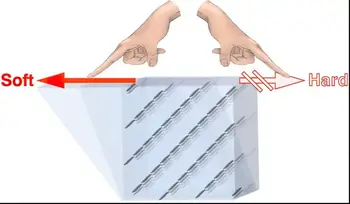Use of the hydrogel in a gravity-defying water-droplet transfer application
Engineers at Japan’s RIKEN Center for Emergent Matter Science have developed a composite material that can direct mechanical energy. Hydrogels with nanofillers hold revolutionary potential for repurposing otherwise lost vibrational energy.
Researchers at the RIKEN Center for Emergent Matter Science have created a novel material that acts in a “nonreciprocal” fashion by channeling mechanical energy in just one direction. The material is based on nanofillers embedded in a hydrogel. The scientists used the composite material, which can be built at different sizes, to cause liquid droplets to ascend within a material by means of vibrational, up-and-down movements. As a result, this substance might be used to make random vibration a helpful tool for propelling matter in a desired direction.
The ability to focus one’s energy in a certain way is a fundamental characteristic that allows for life to exist. The famous Maxwell’s devil, entropy, is the enemy of any closed system, and many fundamental biological processes, including photosynthesis and cellular respiration, are only conceivable because of the nonreciprocal channeling of random fluctuations in nature. There are several applications for preferential energy transport devices, including the conversion of alternating current (AC) to direct current (DC), as well as in photonics, magnetism, and sound. While there are numerous possible applications for electrical energy, it has been more challenging to develop systems that channel mechanical energy.

This task may now be accomplished with relative ease because to a fantastic but uniform material developed by a team led by RIKEN. The team employed a polyacrylamide network hydrogel, a soft polymer composed largely of water, and inserted angled graphene oxide nanofillers into it. Hydrogel is anchored to the ground, so only the top layer shifts in response to shear. Also, the fillers were oriented from top to bottom, moving clockwise.
Shear forces applied from the direction the nanofillers are leaning left cause them to buckle and break down. When facing away from the force, however, the shear exerted only causes them to stretch even further while maintaining their strength. Because of this, the sheet can be bent in only one way without breaking, a property that was quantified by the research team who found that the material was about 60 times as resistant in only one direction as in the other.

To show what could happen, they made a block of the material and set it on a vibrating platform as an experiment. The droplets could be sent to the right or left, or even up through the network but not down, depending on the material’s orientation and design. The vibrational motion might also be used to power a circular motion, which could be made to move in either a clockwise or counterclockwise direction. When the hydrogel was oriented vertically, colored drops injected into it rose seemingly on their own. This was made possible by channeling the hydrogel’s alternating vibrational movements, which are often useless, into useful net motion.
C. elegans worms, which generally move randomly, all moved to one side of the hydrogel, depending on its orientation, in a final test conducted in partnership with researchers from the RIKEN Hakubi Fellows program.
“It was a remarkable and surprising result,” said Yasuhiro Ishida, the project’s leader and a researcher at the RIKEN Center for Emergent Matter Science. “Seeing how mechanical energy could be channeled in one direction preferably, in such a clear way, and using a material that is rather easy to make and quite scalable was a revelation.” We want to develop uses for this material in the future so that we may put its vibrational energy to good use, which is currently being wasted.








